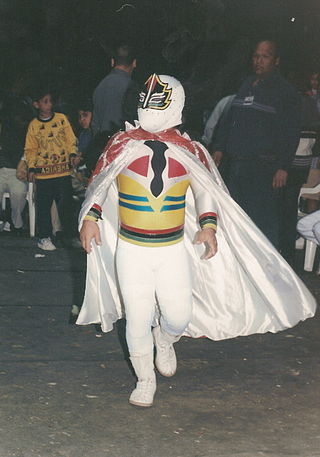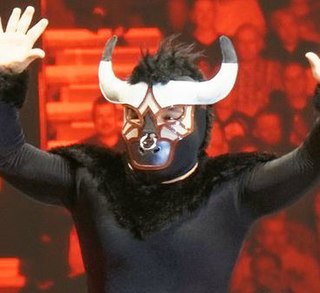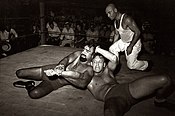
Midget wrestling is professional wrestling involving people of exceptionally short stature. Its heyday was in the 1950s and 1960s, when wrestlers such as Little Beaver, Lord Littlebrook, toured North America, and Sky Low Low was the first holder of the National Wrestling Alliance's World Midget Championship. In the following couple of decades, more wrestlers became prominent in North America, including foreign wrestlers like Japan's Little Tokyo.

Mascarita Sagrada is a Mexican Mini Luchador enmascarado and one of the most well-known Mexican Minis of the modern era. He is the original Mascarita Sagrada although there have been several wrestlers who have used the same gimmick through the years. In Mexico, Mascarita Sagrada has worked for AAA, Consejo Mundial de Lucha Libre (CMLL) and a long list of independent promoters over the years. He has also worked for American wrestling promotions World Wrestling Federation/Entertainment (WWF/WWE), World Championship Wrestling (WCW), Total Nonstop Action Wrestling (TNA) and Lucha VaVOOM. In the late 1990s he worked for the WWF as Mini Nova. He has also been featured in several films and marketing campaigns, including an uncredited cameo in the film My Giant with Billy Crystal and an ad campaign for Virgin Mobile.

The CMLL World Mini-Estrellas Championship, also known as the CMLL World Pequeno Estrellas Championship is a professional wrestling championship promoted by the Mexican Lucha libre wrestling-based promotion Consejo Mundial de Lucha Libre. The championship is exclusively competed for in the Mini-Estrellas, or Minis, division. A "Mini" is not necessarily a person with dwarfism, as in North American Midget wrestling; it can also be short wrestlers who work in the Mini-Estrellas division. The championship was created in 1992 and is the oldest active Mini-Estrella title in Mexico; both the Mexican National Mini-Estrella Championship and the Lucha Libre AAA Worldwide (AAA) World Mini-Estrella Championship were introduced after CMLL created their Mini-Estrella championship. As it is a professional wrestling championship, it is not won legitimately; it is instead won via a scripted ending to a match or awarded to a wrestler because of a storyline. All title matches take place under two out of three falls rules.

Pierrothito is a Mexican luchador enmascarado, or masked professional wrestler. Pierrothito is a part of Consejo Mundial de Lucha Libre's (CMLL) Mini-Estrella, or "Mini", division and is a former CMLL World Mini-Estrella Champion. He is also the first Mini to have held the Mexican National Lightweight Championship. Pierrothito is Spanish for "Little Pierroth", alluding to the fact that he wrestles as a mini version of Pierroth, Jr.; he is sometimes billed as "Mini Pierroth" or "Pequeño Pierroth". Pierrothito's real name is not a matter of public record, as is often the case with masked wrestlers in Mexico where their private lives are kept a secret from the wrestling fans.

Miguel Ángel Arciniega Peña, better known by his ring name Último Dragoncito, is a Tapatío Mexican luchador who works for Consejo Mundial de Lucha Libre (CMLL). He is part of the Mini-Estrella, division and is the only wrestler to hold the CMLL World Mini-Estrella Championship twice. His ring name alludes to the fact that he wrestles as a mini version of Último Dragón. He originally worked as Misteriosito from his debut until 1992 when he was given his current ring name. On July 29, 2022, he lost his mask to Pequeño Olímpico at a Viernes Espectacular show.

The Mexican National Mini-Estrella Championship, also referred to as the Mexican National Minis Championship, is an inactive professional wrestling championship sanctioned by Comisión de Box y Lucha Libre Mexico D.F.. While the commission sanctioned the title, it did not promote the events at which the championship was defended. Asistencia Asesoría y Administración (AAA) promoted the events and had the everyday control of the championship. The championship was exclusively for wrestlers in the Mini-Estrellas, or Minis, division. A "Mini" is not necessarily a person with dwarfism, as in North American Midget wrestling; wrestlers who do not have dwarfism but are very short also work in the Mini-Estrellas division. As it was a professional wrestling championship, it was not won legitimately; it was instead won via a scripted ending to a match or awarded to a wrestler because of a storyline. All title matches took place under two out of three falls rules.
Mario Pérez Jiménez was a Mexican Mini-Estrella luchador, or Mini professional wrestler, best known under the ring name Espectrito. Jiménez worked for the World Wrestling Federation as "Mini Vader" and "El Torito" between 1997 and 1999. Jiménez was the first ever Mexican National Mini-Estrella Champion and IWC World Mini-Estrella Champion. Jiménez was originally an enmascarado, or masked wrestler, under the Espectrito name but lost it to Mascarita Sagrada in a Luchas de Apuestas match, a bet match where each wrestler puts his mask on the line. The Espectrito ring character is a Mini-version of wrestler Espectro, who was a well-known Luchador from the 1960s-1980s.

Tzuki is a Mexican Luchador enmascarado, or masked professional wrestler, who works as a Mini-Estrella or "Mini" division in Mexico. Throughout his career Tzuki has worked under various ring names, most notably Máscarita Sagrada Jr., Mini Rey Misterio Jr. and Max Mini. Tzuki has worked for (AAA), the World Wrestling Federation (WWF) and a variety of special appearances for independent promotions all over Mexico, the United States, Europe and Japan and currently works for Consejo Mundial de Lucha Libre (CMLL). Tsuky's real name is not a matter of public record, as is often the case with masked wrestlers in Mexico where their private lives are kept a secret from the wrestling fans. While not all Mini-Estrellas in Mexico have dwarfism, Tzuki is one of the Mini-Estrellas that actually does.

Mascarita Dorada, is the ring name of a Mexican Luchador enmascarado, or masked professional wrestler, who works in the Mini-Estrella division, comparable to midget wrestling. He is also known for his tenure with WWE under the ring name El Torito.
Mini Abismo Negro is the ring name of a Mexican Luchador enmascarado who works in the Mini-Estrella division for Asistencia Asesoría y Administración (AAA). Mini Abismo Negro is a former, two time Mexican National Mini-Estrellas Champion and the former AAA World Mini-Estrella Champion, the only wrestler to hold both titles. Mini Abismo Negro's real name is not a matter of public record, as is often the case with masked wrestlers in Mexico where their private lives are kept a secret from the wrestling fans. Working in the Mini division does not automatically mean that he has dwarfism as several short wrestlers work in the "Mini" division, including Mini Abismo Negro.
Humberto Sánchez Medorio is a Mexican luchadorEnmascarado, or masked professional wrestler, better known by his ring name Pequeño Black Warrior, or Pequeño Warrior. Sánchez works for the Mexican professional wrestling promotion Consejo Mundial de Lucha Libre (CMLL), in their Mini-Estrella division as a smaller version of wrestler Black Warrior. Sánchez previously worked for Asistencia Asesoría y Administración (AAA) as Mini Psicosis, a smaller version of the wrestler Psicosis. Working in the Mini division does not necessarily mean that Sánchez has dwarfism as several short wrestlers work in the "Mini" division, which is what separates the Mexican Mini-Estrella from traditional Midget wrestling as practiced in the United States and other places.
Rolando Fuentes Romero is a Mexican Luchadorenmascarado better known under the ring name Mini Histeria. Fuentes works for Lucha Libre AAA Worldwide (AAA) in their Mini-Estrellas division. Fuentes is the son of Luchador Rocco Marvin and the brother of Ricky Marvin. He previously worked as Rocky Marvin. winning the Mexican National Mini-Estrella Championship under that name. As Mini Histeria he is part of Los Mini Vipers along with Mini Abismo Negro and Mini Psicosis. Working in the Mini division does not necessarily mean that Fuentes has dwarfism as several short wrestlers work in the "Mini" division, including Rolando Fuentes.
Enrique Del Rio is a Mexican Luchadorenmascarado, or masked professional wrestler who has worked for Lucha Libre AAA World Wide's (AAA) Mini-Estrella division since AAA was founded in 1992. Del Rio currently works under the ring name Mini Psicosis, a smaller version of Psicosis II, and is a former AAA World Mini-Estrella Champion. Until 2008 he worked as Jerrito Estrada, a smaller version of the wrestler Jerry Estrada. As Estrada Del Rio has held the Mexican National Mini-Estrella Championship once, being the shortest reigning champion in the title's history. Working in the Mini division does not automatically mean that he has dwarfism as several short wrestlers work in the "Mini" division, including Enrique Del Rio.

Javier Cortes Sánchez is a Mexican Luchador, or professional wrestler who works for Consejo Mundial de Lucha Libre (CMLL) in their Mini-Estrella division. Cortés is better known under the ring name Shockercito, a mascota version of wrestler Shocker. Cortés was originally an enmascarado, (masked) character, but was forced to unmask after losing a Lucha de Apuesta, or bet match, on January 11, 2009. Working in the Mini division does not necessarily mean that Cortés has dwarfism as several short wrestlers work in the "Mini" division, which is what separates the Mexican Mini-Estrella from traditional Midget wrestling as practiced in the United States among other places.
Pequeño Violencia is a Mexican Luchador who has worked in the Mexican Mini-Estrella division since his debut in 1990. As Pequeño Violencia he wrestles as a smaller version of professional wrestler Violencia. He previously wrestled under the ring name El Fierito, a smaller version of wrestler La Fiera. Working in the Mini division does not necessarily mean that he has dwarfism as several short wrestlers work in the "Mini" division, which is what separates the Mexican Mini-Estrella from traditional Midget wrestling as practiced in the United States and other places.

The Pequeño Reyes del Aire Tournament is an annual wrestling tournament promoted by the Mexican professional wrestling promotion Consejo Mundial de Lucha Libre (CMLL) and has been held since 2007, holding two tournaments in 2012, and one every other year. The tournament includes a varying number of wrestlers, competing in a Torneo cibernetico match, essentially a multi-man elimination match with the last competitor remaining is declared that year's Pequeño Rey del Aire and is given a trophy. The match is based on CMLL's Reyes del Aire tournament which has an identical purpose, format and award. The winner is not normally awarded with a match for the CMLL World Mini-Estrella Championship or the Mexican National Lightweight Championship, the two Mini-Estrellas championships that CMLL promotes, as a direct result of their tournament victory but has as times been used to build but either a championship match or storylines between rival wrestlers.

Octagoncito is a Mexican Luchadorenmascarado, or masked professional wrestler, who works in the Mini-Estrellas ("Mini-Stars") division on the Mexican Independent circuit. He is the first wrestler to work as Octagoncito, with Asistencia Asesoría y Administración (AAA) giving the same ring character to a second Octagoncito when the original one left the promotion in 1995. Octagoncito's real name is not a matter of public record, as is often the case with masked wrestlers in Mexico where their private lives are kept a secret from the wrestling fans. In addition to working for AAA Octagoncito has also worked for Consejo Mundial de Lucha Libre (CMLL), Lucha Libre USA, World Wrestling Federation (WWE), World Championship Wrestling (WCW) New Japan Pro-Wrestling (NJPW) and a slew of smaller wrestling promotions. Working in the Mini division does not necessarily mean that Octagoncito has dwarfism, as short wrestlers can also work in the "Mini" division.
Javier Teucli Roldán (born July 3, 1968, in Puebla, Puebla, Mexico, is a retired Mexican Luchador or professional wrestler best known under the name Sombrita. Teucli also worked under the ring name Pequeño Bronce early in his career as a smaller version of the wrestling character Bronce. Teucli worked in the Mini-Estrella division his entire career, working in the Mini division does not necessarily mean that Teucli has dwarfism as several short wrestlers work in the "Mini" division, which is what separates the Mexican Mini-Estrella from traditional Midget wrestling as practiced in the United States among other places.
Super Muñequito is the most well known ring name of a retired Mexican Luchador enmacarado or masked professional wrestler. He started his career under the name Aguilita Solitaria and then later Angelito Azteca before adopting his most well known moniker, a Mini-Estrella version of Super Muñeco. Starting in 2010 he began working as Mini Super Astro. While he has been working in the Mini-Estrella division his entire career, it does not necessarily mean that he has dwarfism as several short wrestlers work in the "Mini" division as well, which is what separates the Mexican Mini-Estrella from traditional Midget wrestling as practiced in the United States among other places.
Raymundo Rodríguez was a Mexican luchador or professional wrestler best known under the ring name Piratita Morgan. He also worked as an enmascarado, or masked wrestler, under the names Battalion, Payasito Rojo and Coquito Rojo. Rodríguez was one of the first wrestlers to compete in the Mini-Estrella division in Mexico, a division for both dwarf wrestlers and wrestlers of short stature, often portraying a smaller version of a regular-sized wrestler. Rodríguez performed as a shorter version of Pirata Morgan from the beginning of his career to his death. Rodríguez's brother was also a Mini-Estrella, known under the ring name Espantito. He is not related to the wrestler known as Piratita Morgan Jr.













